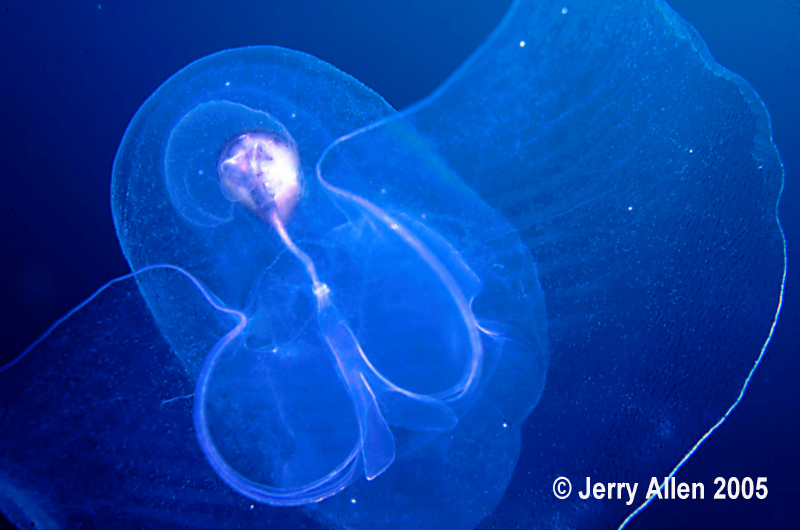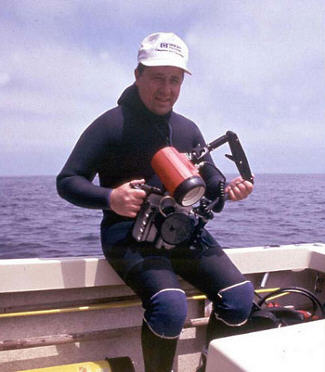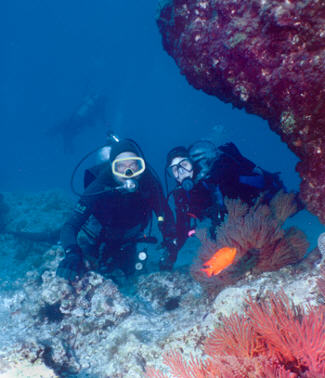 |
Corolla spectabilis
Photo taken in blue water off San Diego (10 to 15 ft.)Photo courtesy of Jerry Allen
Corolla spectabilis Dall, 1871
Variation is a major driving force of evolution. Without variation, natural selection would not occur. Hence one can say that if there is no variation, there would be no evolution. A simple, null-hypothesis, that lends incredible supportive documentation to our understanding of life on earth.
One is tempted to say that biological variation always exists; but then that contradicts "variation," especially in view of parthenogenesis, cloning and identical twins!
I tell my students in biology class, "one should tend not to say never, and usually it is best not to say always." One may explain benthic and pelagic life-styles with the statement that most opisthobranchs are benthic (= bottom dwellers), and most fish are pelagic (i.e., they live up in the water column).
This week’s highlighted opisthobranch is one of these exceptions. Because of my lack of personal experience with this group, a large portion of the text is quoted from recognized experts. This BOW was prompted by seeing Jerry Allen’s extraordinary open-water in situ photographs of this species in blue water off San Diego.
Corolla spectabilis is a member of Family Cymbuliidae, within the gastropod order Thecosomata.
Thecosomes have been divided into two suborders, Euthecosomata and Pseudothecosomata. McGowan (1968: 103) notes that the "fundamental difference between the two suborders is in the arrangements of the foot and fins. The fins of the Pseudothecosomata are united into a continuous ‘swimming plate’ that is ventral to the mouth. The fins of the Euthecosomata are separate and dorsal to the mouth. At the dorsal margin of the swimming plate in the Pseudothecosomata there is a proboscis-like structure composed of two parts: lateral lips and a posterior ‘foot lobe.’ These form a ciliated gutter which leads to the mouth."
Wrobel & Mills (1998: 72) describe this group quite succinctly:
"The thecosomes are a group of about 50 species of planktonic opisthobranchs that along with gymnosomes are known as pteropods (for ‘wing foot’). All possess a mantle cavity (usually with a small gill) and a reduced foot with greatly enlarged epipodia used for swimming. Thecosomes feed passively while drifting by using a large external mucous web. The web and attached food particles are ingested by the mouth with lateral jaws and usually a radula. As indiscriminate omnivores, they trap a range of prey, including bacteria, copepods and other crustaceans, gastropod larvae, dinoflagellates, diatoms and radiolarians....Thecosome adaptations for a planktonic existence include gelatinous bodies, thin shells, ciliary mucous feeding mechanism, protandrous hermaphroditic reproduction (starting as males) and production of floating egg masses. Due to the characteristic pattern of wing flapping, thecosome pteropods are commonly known as ‘sea butterflies.’"
Lalli & Gilmer (1989: 69-73; 130) describe other aspects of the anatomy of Corolla species:
"...Corolla and Gleba [another genus of Cymbuliidae] do not have an external shell; instead, the skeletal support and protection of the viscera is provided by an internal [gelatinous] pseudoconch, or false shell....The transparent pseudoconch contains a cavity that encases the compact visceral mass . The span of the wingplate of Corolla and Gleba is approximately 1.5 to 2 times that of the pseudoconch length, whereas Cymbulia has a smaller, heart-shaped swimming plate with a span rarely exceeding the pseudoconch length. The wings of Corolla are almost oval, with slight indentations along the anterior and lateral margins. [The genus] Gleba, however, has distinct indentations on the anterior margin, which divide the wingplate into two lobes....In Corolla, mucous glands are embedded in the lateral edges of the swimming plate....
"The cymbulids also are characterized by a pronounced increase in the development of the proboscis. The proboscis of Cymbulia is relatively short and fused with the posterior surface of the swimming disk; in Corolla, it is slightly longer and only partially fused....Correlated with the development of the proboscis is a loss of the buccal mass in Corolla and Gleba, both of which lack the radula, jaws, and salivary glands....
"Corolla has simple light-perceptory organs that appear as numerous, dark, pigmented spots around the periphery of the wing margin. Each organ is composed of a simple lens or vesicle filled with dense fluid and bounded laterally by numerous, heavily innervated, pigmented receptor cells."
"Few pseudothecosomes have been carefully examined for epifauna or parasites....Hyperiid amphipods (Lycaea spp.) Have been observed on both Corolla spectabilis and Gleba cordata."
The black and white figure (from McGowan, 1968: plt. 16) illustrates features of the anatomy of Corolla spectabilis. The large figure is a dorsal view of a specimen about 5.5 cm long, that had been collected from the central mixed zone of the California Current, approximately between Bahía San Quintin, Baja California (30° N), and Bahía Tortugas, Baja California Sur (27° N) (see McGowan, 1968: plt. 18 for map).
This epipelagic species occurs from north of Point Conception (California) to south of Punta Eugenia (middle of Baja California peninsula).
ACKNOWLEDGMENTS: I am especially grateful to Dr. Roger Seapy for providing me with a copy of the Lalli & Gilmer reference, and his (and Dr. Carol Lalli’s) assistance in identifying the species. And most especially to Jerry Allen (of San Diego) for his magnificent photos.
REFERENCES:
Lalli, Carol, M., & Ronald W. Gilmer. 1989. Pelagic snails: the biology of holoplanktonic gastropod mollusks. Stanford University Press, Stanford, California. 259 pp.
McGowan, John A. 1968. Thecosomata and Gymnosomata. The Veliger 3 (Supplement), Part Two: 103-129.
Wrobel, David, & Claudia Mills. 1998. Pacific coast pelagic invertebrates: a guide to the common gelatinous animals. Sea Challengers & Monterey Bay Aquarium, Monterey, California. 108 pp.
Imperial Beach, Calif
Jan. 2005

In 1992, while accompanying a group of CAS marine biologists to the island of Mindanao in the Philippines, he documented a new species of nudibranch which was named for him. See Ceratosoma alleni . He has traveled extensively throughout Asia documenting the marine animals that proliferate this region. He is also an avid nature photographer and is available for field animal behavior documentation assignments. Jerry recently took first place in the advanced division for the best of 2004 during the January competition at SDUPS. See his awesome pigmy seahorse image from the Lembeh Straits!Send Jerry mail at uwshooter@aol.com
or visit his website at uwshooter.com |
Descriptive taxonomy and anatomy text assembled and
written by Hans Bertsch.

Send Hans mail at hansmarvida@sbcglobal.net
|
